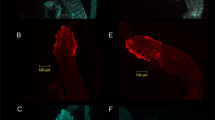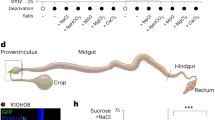Abstract
IN terrestrial insects the rectum is a major site of fluid absorption and is, therefore, important in the physiological control of water balance. Water absorption in the insect rectum occurs against osmotic gradients greater than 300 mosmol 1−1 and apparently in the absence of net ion movements from lumen to haemolymph1,2. Evidence suggests that net water flow from the rectal lumen to haemolymph results from increases in intercellular space osmotic pressure due to the transport across lateral cell membranes of recyclable intracellular solutes3,4. Little is known about the mechanism of water transport in the insect gut anterior to the rectum nor about gastrointestinal processes involved in water regulation in other terrestrial arthropods. Scorpions are ideal organisms for measurements of arthropod deal transport because this part of the gut extends nearly the entire length of the tail and can be isolated for in vitro perfusion. We present here preliminary information on a sodium-dependent, potassium-inhibited water transport mechanism in the ileum of the desert scorpion Hadrurus arizonensis.
This is a preview of subscription content, access via your institution
Access options
Subscribe to this journal
Receive 51 print issues and online access
$199.00 per year
only $3.90 per issue
Buy this article
- Purchase on Springer Link
- Instant access to full article PDF
Prices may be subject to local taxes which are calculated during checkout
Similar content being viewed by others
References
Phillips, J. E., J. exp. Biol., 41, 15–38 (1964).
Wall, B. J., J. Insect Physiol., 13, 565–578 (1967).
Oschman, J. L., and Wall, B. J., J. Morph., 127, 475–510 (1969).
Maddrell, S. H. P., in Advances in Insect Physiology, 8, (edit. by Beament, J. W. L., Treherne, J. E., and Wigglesworth, V. B.), 119–331 (Academic, London and New York, 1971).
Kanungo, M. S., Biol. Bull., 113, 135–140 (1957).
Padmanabhanaidu, B., Comp. Biochem. Physiol., 17, 161–181 (1966).
Jeuniaux, C., in Chemical Zoology, 6, (edit. by Florkin, M., and Scheer, B. T.), Part B, 64–118 (Academic, London and New York, 1971).
Burg, M. B., and Orloff, J., J. clin. Invest., 47, 2016–2024 (1968).
Wigglesworth, V. B., Q. J. microsc. Sci., 75, 131–150 (1932).
Ramsay, J. A., J. exp. Biol., 32, 183–199 (1955).
Pavlovsky, E. N., and Zarin, E. J., Q. J. microsc. Sci., 70, 221–261 (1926).
Tormey, J. M., and Diamond, J. M., J. gen. Physiol., 50, 2031–2060 (1967).
Diamond, J. M., and Bossert, W. H., J. gen. Physiol, 50, 2061–2083 (1967).
Diamond, J. M., Fedn Proc., 30, 6–13 (1971).
Author information
Authors and Affiliations
Rights and permissions
About this article
Cite this article
AHEARN, G., HADLEY, N. Functional roles of luminal sodium and potassium in water transport across desert scorpion ileum. Nature 261, 66–68 (1976). https://doi.org/10.1038/261066b0
Received:
Accepted:
Issue Date:
DOI: https://doi.org/10.1038/261066b0
This article is cited by
-
Transepithelial transport of zinc and l-histidine across perfused intestine of American lobster, Homarus americanus
Journal of Comparative Physiology B (2007)
Comments
By submitting a comment you agree to abide by our Terms and Community Guidelines. If you find something abusive or that does not comply with our terms or guidelines please flag it as inappropriate.



